Anthroposophic Nursing Care of Premature Infants
Natalie Hurst
Last update: 20.11.2020
What can be the mission in the nursing care of a prematurely born person and his family?
When a baby is born, parents are faced with new challenges: to take responsibility for a small human being, to provide him or her with nourishment, warmth and love. Worries and uncertainties can arise even at the birth of a mature, healthy baby. However, when a sick or premature baby is born, this is often a distressing situation for the parents. The family must overcome worries about the baby’s health, grief over the early loss of the baby from the womb, possibly trauma due to an overwhelming birth. The parents are occupied with questions about how things will proceed now and how long the baby will need medical support. Especially mothers often feel as if they have failed in their role as mothers, because they could not carry their baby to the end. The question of why a child was born too early often remains an issue for parents for a long time.
We encounter similar issues in nursing when we come into contact with the individuality of a baby born too early. We meet newborns who immediately want to breathe and drink independently, observe the world with interest and curiosity and clearly show what they like and what they don’t like. Then there are newborns who have difficulty breathing. They often take breaks from breathing and would not continue to breathe if we did not remind them through stimulation. Their new environment is too much for them and they remain in a world to which we apparently have no access. This already indicates that the further course of their development may be influenced by the fact of whether or not they felt willing to transition to extrauterine life despite preterm birth. Therefore we ask ourselves in the care of premature babies: did the baby want to come so soon? Did the baby trigger the birth or was the birth initiated due to a problem of the mother? What did the baby experience during pregnancy? In what family environment did he or she develop during the pregnancy? Due to the often long stay in the neonatal ward and the close contact with the family, we nurses often become aware of topics that were prenatally formative: difficulties that the premature baby has, or difficulties in forming a bond between parents and child, or problems with breastfeeding. If we want to provide holistic support for the premature baby and his or her family – i.e., to understand them better and offer suitable nursing measures – we must look at the chronological arc from the prenatal period to the here and now.
Furthermore, we may consider the question of how to accompany the baby on his way from the sphere of intrauterine, weightless life to extrauterine life. We can invite him to find a way from the place where he would actually still be now (if he had not been born prematurely) to life on earth. We can express our invitation like this, for example: “Look! Something of where you come from is also here!” – as well as by appealing to the baby’s senses in the way that we care for him, appropriate to his age.
An approach to such care of the baby’s senses can be found by looking at the enveloping embryonic organ, the amnion. This enveloping organ has lost the baby too early. Starting from the importance of this organ, we can look at the needs of the premature infant and develop nursing competence that not only keeps an eye on the here and now, but also builds a bridge from the past to the future of the premature infant in his family.
Amnion – A gesture of enveloping
The amniotic sac forms the original covering that protects the baby – it is a protective organ par excellence. With its skin it forms a boundary to the outside world, yet one which remains transparent for gentle first impressions from outside, like the baby’s own first small vaulted sky. In the womb, amniotic fluid makes a sea-like space for the baby. The unborn baby can develop in this weightlessness. The amniotic sac enables vitality, movement and growth and is a central organ of the baby’s life organization. The baby’s neurosensory system can mature in this protective covering and it is shielded from too much stimuli.
If this protective covering is lost prematurely, the baby’s not yet fully developed body is affected too early by extrauterine gravity. For nurses, one of the most important tasks is to make the wide space of the world in which the baby suddenly finds himself into a manageable, contained and safe place in accordance with the baby’s stage of development. This can be achieved through the nursing gesture of enveloping. This gesture is important for the baby as well as for the parents who have suddenly become father and mother, who are often insecure in this situation and need a protected, loving place to be in contact with their baby and to process their experiences. The gesture of enveloping is present in all our nursing care actions, especially in rhythmical embrocation, swaddling and bathing.
Bathing premature infants
When bathing a prematurely born infant, we can create a space for healing. Besides caring for the baby’s senses, besides the cleansing and calming effect, bathing can become a ritual of healing for an early loss of amniotic fluid. In the bath the baby gets another opportunity to feel the lightness, the surrounding warmth and the sense of being carried, like in the mother's womb. As nurses, we can create an opportunity for the mother and child to continue the pregnancy while bathing. Through statements like: “It may have felt similar in her belly” or: “Now you can move like in her belly”, we can offer the opportunity for a conversation about the pregnancy. Since the baby enjoys this time of bathing, it can be unpleasant to come out of the water back into the world of gravity and coolness. We can consciously accompany this step, as at birth, where the baby goes from his previously safe place into a world that offers completely different conditions. We calmly take the baby out of the water, announce that we are going to do this and tell him that he will now be safely wrapped in a warm towel and that we are happy that he is there. We consciously place the baby into gravity and into the world, which we create in such a way that the baby feels safe in it: through warmth, through enveloping the baby emotionally and physically.
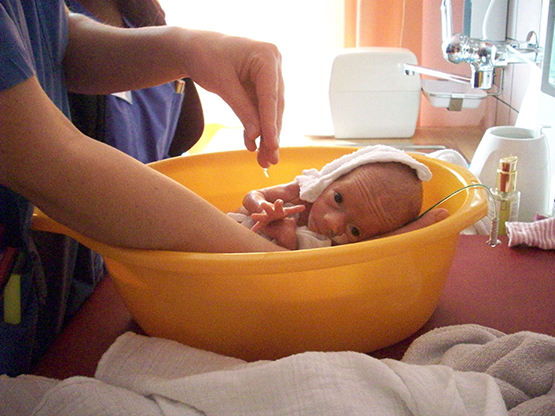
Fig. 1: When bathing, a washcloth is used to give protective covering. © Natalie Hurst
Rhythmical embrocation for premature babies
When we administer a rhythmical embrocation we rub the baby in a rhythm of binding and releasing: binding happens in increasing contact and in increasing intensity of contact. As a gesture, binding is awake and perceptive, warm and full. The gesture of releasing is one of diminishing contact and diminishing intensity of contact, letting go of the tissue. Through this rhythm between binding and releasing we stimulate the baby’s life forces and create a warmth impulse. The premature baby can calm down.
Before beginning the treatment, it is important to create a safe, enveloping place in which the baby can feel secure to experience the rhythmic quality of binding and releasing that stimulates his life forces and can evoke a sensation similar to the previous space of intrauterine buoyancy. A safe space includes the person giving the treatment and the surroundings. The practitioner takes a short moment to establish good contact with the earth and to take a few deep breaths to become calm and slow herself. The environment must be designed in such a way that the baby can rest his weight on the surface beneath him, as otherwise he will be occupied with regulating his position during the treatment. We create a boundary around the baby, in which he can lay down his arms and legs and be covered. Only then do we start the treatment with an enveloping gesture: we envelop his head with our hands, leaving a little distance between our hands and the baby’s skin. In the first days of life, it is advisable to stay in place during the treatment. We bind and release in place, on the baby’s chest, abdomen, legs or feet. Only when the baby becomes more secure and no longer flinches or tries to regulate himself with every movement, does it make sense to start expanding our movements. With older premature babies, ones who have become ready to look around, our movements can make a contribution to their further development, particularly in terms of caring for the baby’s senses. Here it is also important to offer guidance to the parents, who can continue the rhythmical oil applications at home to support the baby’s development and strengthen their bond with him through regular skin contact and interaction.

Fig. 2: Our hands form an enveloping gesture. © Natalie Hurst
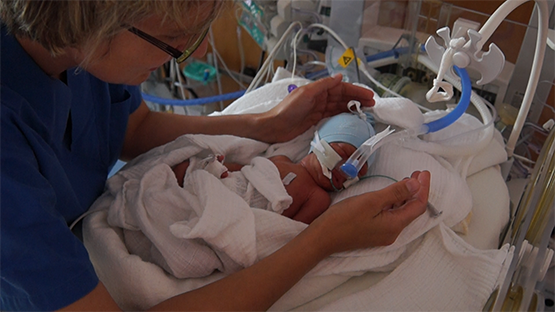
Fig. 3: Our hands form an enveloping gesture. © Natalie Hurst
Our hands begin with an enveloping gesture. This is the first step, the fixed constant in the oil application and at the same time an intimate encounter. It enables us to perceive the little human being with everything that he or she brings along. When we remain in this moment and refrain from immediately proceeding into action, it allows us to perceive exactly under which aspect the oil application will stand. The first thing we see is a premature baby who obviously recognizes the application and radiates curiosity and joy in contact. If so, the treatment can stand more under the aspect of sensory care, discovery of the world and development. The second thing that we may notice is exhaustion, a sense of being overwhelmed and a body that can hardly escape the force of gravity. In that case our treatment will stand more under the aspect of enveloping, giving support and welcoming the baby. These two treatments are presented below.
1. Rhythmical embrocation under the aspect of sensory care
Stimulation of the senses during birth is so profound and unique that we observe consequences for sensory development in babies who have undergone any kind of intervention during birth. This is best investigated in babies born by caesarean section. Oil applications appeal to the senses in a special way and can support healthy sensory development.
The sense of touch
Oil applications especially address the baby’s sense of touch. Through the sense of touch we experience the limits of our body and thus get an idea of our physical body. The newborn baby has had one of the most essential tactile experiences, namely that of birth itself. When passing through the narrow birth canal, the baby clearly perceived his physical body and his relationship to his mother’s birth canal. He thus received clear tactile stimulation, and the clear experience: “I am.” When a baby is delivered by caesarean section, this stimulation of the sense of touch, the experience of one’s own self during birth, is missing: “Am I there yet?” By means of rhythmical oil applications we can make the baby’s physical body perceptible through tactile stimulation, the baby can feel: “This is me and I am being held.” This strengthens basic trust.
The sense of movement
The next sense that is clearly addressed when passing through the birth canal is the sense of movement: how can I move in relation to the birth canal, how do my movements and the contractions of the uterus bring me forward? Behind a movement is a goal, a thought: I move in order to advance in a certain direction, in this case to be born. The baby’s sense of movement perceives these body movements and gives information about the baby’s position in space. If it goes ahead, I get confirmation that what I am doing is effective. If there are difficulties in moving through the birth canal, feelings of frustration may arise. For example, the baby may have gotten wedged in, or the position of his head is not yet correctly adjusted and the contractions are pressing against his pelvis. During a caesarean section, the baby cannot keep up with the rapid movements that are used to accompany him on his way out.
When we administer an oil application we leave the possibility for movement open. The baby is allowed to move along with us and learns that his movements are effective. Through our slow movements when repositioning, we allow the baby time to keep up with what is happening through his sense of movement.
We can start with the back; the baby is present and goes along with our back strokes. A peaceful binding quality of touch on the upper back, a releasing in the direction of the sacrum, perceiving the entire back with the flat of our hand. Allow the baby to move on his own; our centering on the middle of his body allows him to suck better.
Video: Rhythmical embrocation for premature babies © Natalie Hurst
After the back we treat the chest. We bind and release in place, with the baby’s arms enveloped. The baby’s front side is more sensitive, softer and more vulnerable than the back. To start moving there requires prior attunement and it is often too much for very jumpy, restless babies.
Once the baby has become quiet through the binding and releasing in place and signals: “I am ready for something new”, we can stroke his arms. We use a binding quality of touch in the entire upper arm and releasing strokes out to the fingers. A baby who is familiar with these rhythmic movements can surrender and listen with his inner ear in a relaxed manner.
We treat his belly with binding and releasing qualities of touch in place. One hand is under the baby’s back and the other hand is on his stomach. Experienced practitioners can move along the colon with wandering attention: binding at the ascending colon, releasing at the transverse and descending colon.
The same procedure is used for the baby’s legs as for the arms and chest. We bind and release in place, with enveloping gestures, then stroke out the legs as needed. Binding on thighs, releasing towards the lower legs and feet.
Finally, we hold the baby’s head and feet. We once again perceive the baby as a whole.
2. Rhythmical embrocation under the aspect of enveloping protection and stability
This treatment is done under the aspect of stabilization. It is suitable for babies who have been overwhelmed by birth and show shock-like symptoms. It is the baby’s sense of life which may be particularly addressed or relieved by this treatment.
The sense of life
Our sense of life perceives the vital condition of our body, the state that it is in, thus enabling perception within the organism. If everything is alright, we feel comfortable and well in our physicality. We usually only perceive our life sense when there is disharmony in our life processes, such as breathing, excretion and nutrition, which can cause sensations such as tiredness, nausea, pain and weakness. These sensations are new to a newborn baby if he has not experienced noxious substances, and has had adequate nutrition and rest while in the womb. A premature baby which has to take up his organ functions too early, is now confronted with such bodily sensations in a sometimes painful way. He is forced a little too early into the conscious perception of his body. By means of rhythmical oil applications we can support a harmonization of the baby’s life processes, and thus create a greater sense of well-being.
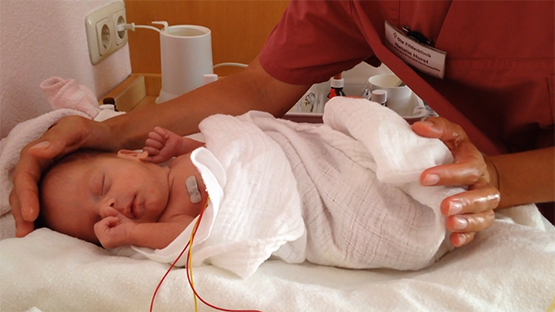
Fig. 4: Enveloping gesture during rhythmical embrocation of a premature baby © Natalie Hurst
The caregiver lingers in the enveloping gesture and enables contact to be established. Our calm perception of the situation is healing for the baby. We proceed particularly slowly and wait for the baby to adjust to each movement. This allows us to adapt to the baby’s own pace.
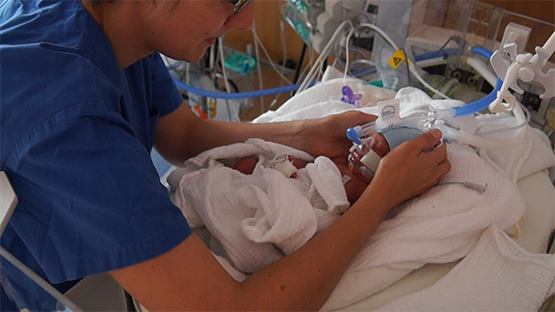
Fig. 5: Establishing contact before rhythmical embrocation of a premature baby © Natalie Hurst
We bind and release in place, on the baby’s chest. The chest area with its lungs and inhalation and exhalation connects the baby to the world. During the oil application we can support the process by binding and releasing, bringing the baby into balance.
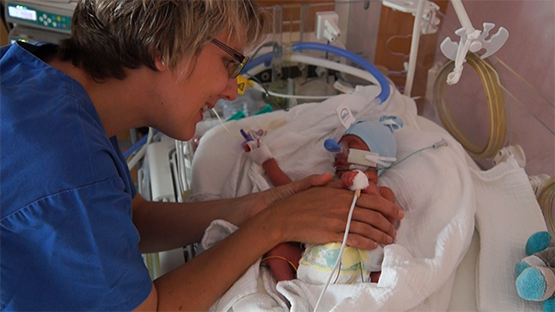
Fig. 6: Rhythmical embrocation of the abdomen for premature babies © Natalie Hurst
We hold the baby’s abdomen in place, binding and releasing. In the picture the baby opens his eyes for the first time during the treatment, after forces for making contact have been released.
We also hold the baby’s legs and feet in place, binding and releasing. The legs with their movements are also an expression of the soul. We are open to the baby’s own movements.
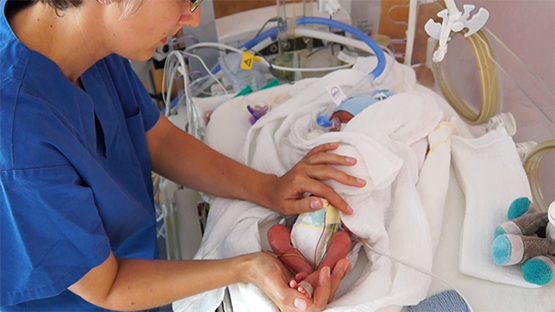
Fig. 7: Holding the feet of a premature baby © Natalie Hurst

Fig. 8: The pushing feet of a premature baby © Natalie Hurst
After holding the baby’s feet, we introduce movement by binding and releasing in place. The baby may stretch his legs powerfully, we admiringly go along with this movement. Towards the end of birth, the baby also pushes himself off with his legs. The baby in Figure 9 was brought into life without self-activity, so we are glad to support the now purposeful self-activity of his legs: “Look how strong you are and how well you can push yourself away!”
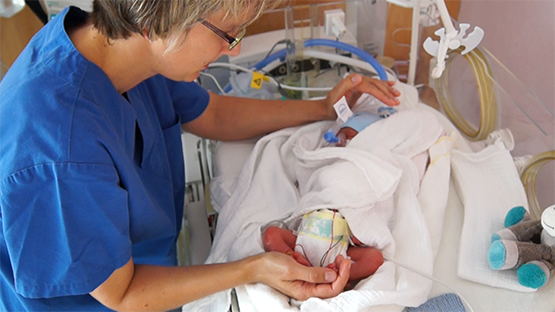
Fig. 9: Contact between the head and the feet of a premature baby © Natalie Hurst
The body oils used in rhythmical embrocation
The surface of the skin in relation to body weight is particularly large in premature babies. In the first weeks of life the baby’s skin is relatively permeable, the formation of the epidermal border, which protects the skin from insensible water loss and mechanical influences, is still in an intensive process. This means that applying an oil can protect against insensitive water loss, care for sensitive skin and help to retain warmth better. An oil that has been formed in a plant by the warmth of the sun is a kind of warmth that has become material, warmth that the oil can release over a long period of time. Fatty oils embody the nourishing aspect of oil. In the first two weeks of a premature baby’s life only base oils should be used, as the baby’s skin can absorb added essential oils in high concentrations. In anthroposophic nursing care, it is not just the ingredients that are important for selecting the right oil. We also pay attention to the special characteristics of the oil plant in terms of growth, fruit formation and appearance. These phenomena provide clues as to their individual use in treating babies.
1. Almond oil
The almond tree grows up to eight meters high. It is bare and frost-sensitive, has gray bark and belongs to the rose family. It is closely related to cherry, peach, apricot and rose. This relationship can be recognized in its pink-colored flowers with yellow stamens, which in Mediterranean countries blossom already in January. The oil is extracted from the almond seed of the hard kernel. The almond kernel is surrounded by several protective shells before the nutrient-rich seed can be exposed. Almond oil has very nourishing ingredients, it soothes irritated and sensitive skin and its nourishing aspect helps new and premature babies to thrive. Its fragrance is reminiscent of marzipan. The oil is mild and warm and elicits feelings of security and harmony.
Almond oil is therefore suitable for babies who seem hurt by early birth, who are more sensitive, weak and in need of protection. Almond oil
- is nourishing,
- it provides security and protection,
- it harmonizes and
- it cares for the skin, soothing irritations.
2. Olive oil
An olive tree can become several hundred years old. It unites in itself the elemental force of the four elements: it stands firmly rooted and can hardly be destroyed, either by water, fire or sun – it is a real (survival) artist. Only cold it cannot stand. If you try to cultivate it in a frost zone, it will die. At all times for Mediterranean people the olive or olive tree has been a symbol of happiness, blessing and peace. It is considered to be the tree that holds closeness to God and God’s wisdom within it, which is why in the south it is often planted near churches, and olive oil is used for anointings and unctions. The oil is pressed from the pulp of the fruit. The flesh of the olive has been storing warmth and sunshine for months and has converted it into oil.
The oil has a thoroughly warming quality. Due to its high content of oleic acid and vitamin E, it is very beneficial for the skin and highly regenerating. The use of olive oil in neonatology has been investigated several times and its skin care properties have been proven in studies. Furthermore it has analgesic and anti-inflammatory effects due to the oleocanthal it contains. Its pain-relieving effect has proven very effective in rhythmical embrocations after breech births, and after forceps or vacuum delivery. Olive oil has a strengthening effect on the whole organism and is
- warming, pain-relieving,
- strengthening, incarnating, supporting in transitional situations,
- skin-regenerating, anti-inflammatory.
Warmth for premature babies
Warmth is one of the most important aspects in the care of premature babis: Thermoneutral care in the incubator, protection against insensible water loss through moistening and application of oil are sufficiently described in the literature. Additional aspects of warmth are explained below.
Sense of warmth
Warmth generation is not only a physical process, warmth is also generated by the contact of two or more human souls, known as heart warmth. This inner soul warmth plays a role in physical warming up to the periphery, in maintaining warmth and thus also in a child’s ability to thrive. This warmth can be created between parents and child through a protective environment that conveys security, stability and confidence.
Another aspect is that the human warmth organization has a unique ability to adapt and regulate compared to other warm-blooded organisms. Warmth regulation plays a leading role in physiological self-regulation. The ‘I’ as the spiritual individuality makes each person an individual with his or her own thoughts and life tasks. The ‘I’ acts in the human being through warmth. In a newborn infant this ‘I’ is still held by the parents to a large extent. To do this, parents must feel confident themselves and have the opportunity to be with their baby, care for him, and have close skin contact. In this way, they can create an optimal connection to their baby’s self and warmth. In babies whose mother is not sufficiently present, we can often observe reduced blood flow to the periphery. These babies often appear slightly marbled and they sometimes thrive less.
To strengthen the protective warmth around the baby we can use rose oil. A mixture with rose essential oil should only be used two weeks after a premature birth. It is strongly diluted, following the recommendations of aroma care for Infants.
3. Rose oil
The rose symbolizes a perfectly harmonious plant. Rosaceae connect firmly and permanently with the earth, they form woody roots and thus represent earthly firmness. On the other hand, rose plants produce an extraordinary scent in their flowers as a result of warmth-light processes, showing their connection to the cosmos. The flower has the basic shape of a five-pointed star. The pentagram is the symbol of the microcosm, where world forces flow together to create a small but independent and self-contained world. The rose is thus able to strengthen the protective covering of the developing small human being, making it one in which the baby can thrive and develop. Rose oil is
- enveloping and promotes thriving,
- harmonizing and
- warming.
Mix 1 drop of pure rose essential oil in 100 ml almond or olive oil.
Bibliography
- Evertz K, Jaus L, Linder R (Hrsg.) Lehrbuch der Pränatalen Psychologie. Heidelberg: Mattes Verlag; 2014.
- Fingado M. Rhythmische Einreibungen. Handbuch aus der Ita Wegman Klinik. 3. Aufl. Arlesheim: Natura Verlag; 2012.
- Heine R (Hrsg.) Anthroposophische Pflegepraxis. Grundlagen und Anregungen für alltägliches Handeln. 4. Aufl. Berlin: Salumed Verlag; 2017.
- Layer M. Praxishandbuch Rhythmische Einreibungen nach Wegman/Hauschka. 2. Aufl. Bern: Huber Verlag; 2014.
- Marcovich M, de de Jong TM. Frühgeborene – zu klein zum Leben? Geborgenheit und Liebe von Anfang an. München: Kösel Verlag; 2008.
- Meissner BR. Emotionale Narben aus Schwangerschaft und Geburt auflösen. 3. Aufl. Selbstverlag; 2020.
- Nischelwitzer A. Babyheilbad nach Brigitte Meissner - Postpartales Bonding fördern. Riga: AV Akademikerverlag; 2015.
- Pelikan W. Heilpflanzenkunde. Bd. 1-III. 8. Aufl. Dornach: Verlag am Goetheanum; 2012.
- Soldner G, Stellmann HM. Individuelle Pädiatrie. Leibliche, seelische und geistige Aspekte in Diagnostik und Beratung. Anthroposophisch-homöopathische Therapie. 5. Aufl. Stuttgart: Wissenschaftliche Verlagsgesellschaft; 2018.
- Soldner G, Stellmann HM. Therapiemöglichkeiten nach gestörtem Geburtsverlauf. Der Merkurstab 1998;51(3):159-164.[Crossref]
- Wilkens J. Die Mandelmistel. Der Merkurstab 2010;63(1):29-45.[Crossref]